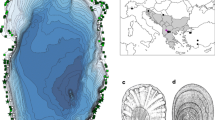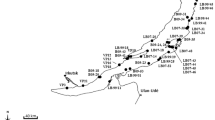Abstract
Ancient lakes have long been recognized as “hot spots of evolution” and “evolutionary theatres” and they have significantly contributed to a better understanding of speciation and radiation processes in space and time. Yet, phylogenetic relationships of many ancient lake taxa, particularly invertebrate groups, are still unresolved. Also, the lack of robust morphological, anatomical, and phylogeographical data has largely prevented a rigorous testing of evolutionary hypotheses. For the freshwater gastropod genus Valvata—a group with a high degree of endemism in several ancient lakes—different evolutionary scenarios are suggested for different ancient lakes. Lake Baikal, for example, is inhabited by several endemic Valvata taxa that presumably do not form a monophyletic group. For such an evolutionary pattern, the term ancient lake species scatter is introduced here. In contrast, for the Balkan Lake Ohrid, workers previously suggested the presence of a monophyletic group of endemic Valvata species, that is, an ancient lake species flock. Sequence data of the mitochondrial cytochrome oxidase c subunit I gene (COI) from worldwide taxa, with a strong emphasis on Balkan species, are here used to test whether the putative Ohrid Valvata endemics represent an ancient lake species flock and to study patterns of speciation both on the Ohrid and the Balkan scale. The study reveals three distinct clades of endemic Valvata in Lake Ohrid. Monophyly of these taxa, however, is rejected, and they therefore do not represent an ancient lake species flock, but rather an ancient lake species scatter. Also, in contrast to many other gastropod groups in Lake Ohrid, the valvatids apparently did not radiate. Many Valvata taxa in ancient lakes are characterized by enhanced levels of shell complexity. However, it remains unclear whether these patterns are associated with ancient lake environments per se. It is here suggested that similarities in shell structure between North American and Balkan taxa might simply be due to convergent evolution.




Similar content being viewed by others
References
Akaike, H., 1974. A new look at the statistical model identification. IEEE Transaction on Automatic Control 19: 716–723.
Albrecht, C., R. Schultheiß, T. Kevrekidis & T. Wilke, 2007. Invaders or endemics? Molecular phylogenetics, biogeography and systematics of Dreissena in the Balkans. Freshwater Biology 52: 1525–1536.
Albrecht, C., S. Trajanovski, K. Kuhn, B. Streit & T. Wilke, 2006. Rapid evolution of an ancient lake species flock: freshwater limpets (Gastropoda: Ancylidae) in the Balkan lake Ohrid. Organisms, Diversity & Evolution 6: 294–307.
Albrecht, C. & T. Wilke, 2008. Lake Ohrid: biodiversity and evolution. Hydrobiologia (this volume).
Albrecht, C., T. Wilke, K. Kuhn & B. Streit, 2004. Convergent evolution of shell shape in freshwater limpets: the African genus Burnupia. Zoological Journal of the Linnean Society 140: 577–586.
Albrecht, C., C. Wolff, P. Glöer & T. Wilke, 2008. Concurrent evolution of ancient sister lakes and sister species: the freshwater gastropod genus Radix in lakes Ohrid and Prespa. Hydrobiologia (this volume).
Bouchet, P. & J.-P. Rocroi, 2005. Classification and nomenclator of gastropod families. Malacologia 47: 1–397.
Burch, J. B., 1982. North American freshwater snails: identification keys, generic synonymy, supplemental notes, glossary, references, index. Walkerana 4: 1–356.
Burch, J. B., 1989. North American freshwater snails: species list, ranges and illustrations. Walkerana 1: 81–365.
Edwards, S. V. & P. Beerli, 2000. Perspective: gene divergence, population divergence, and the variance in coalescence time in phylogeographic studies. Evolution 54: 1839–1854.
Falkner, G., R. A. Bank & T. v. Proschwitz, 2001. Check-list of the marine Molluscan Species-group taxa of the States of Northern, Atlantic and Central Europe (CLECOM I). Heldia 4: 1–76.
Falniowski, A., A. Economou-Amilli & K. Anagnostidis, 1988. Valvata piscinalis O.F. Müller (Mollusca, Prosobranchia) and its epizoic diatoms from lake Trichonis, Greece. Internationale Revue der gesamten Hydrobiologie 73: 327–335.
Folmer, O., M. Black, W. Hoeh, R. Lutz & R. Vrijenhoek, 1994. DNA primers for amplification of mitochondrial cytochrome c oxidase subunit I from diverse metazoan invertebrates. Molecular Marine Biology and Biotechnology 3: 294–299.
Frogley, M. R. & R. C. Preece, 2004. A faunistic review of the modern and fossil molluscan fauna from lake Pamvotis, Ioannina, an ancient lake in NW Greece: implications for endemism in the Balkans. In Griffiths, H. I. & B. Kryštufek (eds), Balkan Biodiversity. Kluwer, Dordrecht: 243–260.
Frogley, M. R. & R. C. Preece, 2007. A review of the aquatic Mollusca from Lake Pamvotis, Ioannina, an ancient lake in NW Greece. Journal of Conchology 39: 271–296.
Glöer, P., 2002. Die Süßwassergastropoden Nord- und Mitteleuropas. ConchBooks, Hackenheim.
Glöer, P. & V. Pešić, 2008. The freshwater gastropods of the Skadar Lake with the description of Valvata montenegrina n. sp. (Mollusca, Gastropoda, Valvatidae). In Pavić, E. D. & M. Perreau (eds), Advances in the Studies of the Subterranean and Epigean Fauna of the Balkan Peninsula. Volume Dedicated to the Memory of Guido Nonvellier. Monography, Institute for Nature Conservation of Serbia: 341–348.
Gorthner, A., 1992. Bau, Funktion und Evolution komplexer Gastropodenschalen in Langzeit-Seen. Mit einem Beitrag zur Paläobiologie von Gyraulus “multiformes” im Steinheimer Becken. Stuttgarter Beiträge zur Naturkunde, Serie B 190: 1–173.
Greenwood, P. H., 1984. What is a species flock? In Echelle, A. A. & I. Kornfield (eds), Evolution of Fish Species Flocks. Orono Press, Maine: 13–19.
Hadžišče, S., 1953. Beitrag zur Kenntnis der Gastropodenfauna des Prespa- und Ohridsees. Periodicum biologorum II/B T. 7: 174–177.
Hadžišče, S., 1956. III. Beitrag zur Kenntnis der Gastropodenfauna des Ohridsees.—Beschreibungen der bis jetzt unbekannten Schnecken und Beispiele der Speciation bei den Gastropoden des Ohridsees. Recueil des Traveaux, Station Hydrobiologique Ohrid 4: 57–107.
Hall, T. A., 1999. BioEdit: a user-friendly biological sequence alignment editor and analysis program for Windows 95/98/NT. Nucleic Acids Symposium Series 41: 95–98.
Haszprunar, G., 1985. The Heterobranchia—a new concept of phylogeny of the higher Gastropoda. Zeitschrift für zoologische Systematik und Evolutionsforschung 23: 15–37.
Huelsenbeck, J. P. & B. Rannala, 1997. Phylogenetic methods come to age: testing hypotheses in an evolutionary context. Science 276: 227–232.
Huelsenbeck, J. P. & F. Ronquist, 2001. MrBayes: Bayesian inference of phylogenetic trees. Bioinformatics 17: 754–755.
Koussouris, T. & M. Pugh-Thomas, 1982. Macrozoobenthic studies in Lake Trichonis—western Greece. Thalassographica 2: 17–25.
Kumar, S., K. Tamura & M. Nei, 2004. Mega3: integrated software for molecular evolutionary genetics analysis and sequence alignment. Briefings in Bioinformatics 5: 150–163.
Maassen, W. J. M., 1980. De zoetwatermollusken van het Ohrid/en Prespameer en hun omgeving. De Kreukel 16: 81–98.
Martens, K., 1997. Speciation in ancient lakes. Trends in Ecology and Evolution 12: 177–182.
Martens, K., G. Coulter & B. Goddeeris, 1994. Speciation in ancient lakes—40 years after Brooks. In Martens, K., B. Goddeeris & G. Coulter (eds), Speciation in Ancient Lakes. Archiv für Hydrobiologie 44: 75–96.
Michel, E., 1994. Why snails radiate: a review of gastropod evolution in long-lived lakes, both recent and fossil. In Martens K., B. Goddeeris & G. Coulter (eds), Speciation in Ancient Lakes. Archiv für Hydrobiologie 44: 285–317.
Miller, M. P., D. E. Weigel, K. E. Mock & B. Roth, 2006. Evidence for an outcrossing reproductive strategy in the hermaphroditic heterobranch gastropod Valvata utahensis (Valvatidae), with notes on the genetic differentiation of V. utahensis and V. humeralis. Journal of Molluscan Studies 72: 397–403.
Nishino, M. & N. C. Watanabe, 2000. Evolution and endemism in Lake Biwa, with special reference to its gastropod mollusc fauna. In Rossiter, A. & H. Kawanabe (eds), Ancient Lakes: Biodiversity, Ecology and Evolution—Advances in Ecological Research, Vol. 31. Academic Press, San Diego: 151–180.
Petridis, D. & A. Sinis, 1995. Benthos of Lake Mikri Prespa (North Greece). Hydrobiologia 304: 185–196.
Polinski, V., 1929. Limnološka ispitivanja Balkanskog Poluostrva I. Reliktna fauna gasteropoda Ohridskog Jezera. Glas Srpska Kraljevske Akademije, Belgrade 137: 129–182.
Posada, D. & K. A. Crandall, 1998. Modeltest: testing the model of DNA substitution. Bioinformatics 14: 817–818.
R Development Core Team, 2008. R: A Language and Environment for Statistical Computing. R Foundation for Statistical Computing, Vienna, Austria.
Radoman, P., 1983. Hydrobioidea, a superfamily of Prosobranchia (Gastropoda), I. Systematics. Serbian Academy of Sciences and Arts, Belgrade: 1–256.
Radoman, P., 1985. Hydrobioidea, a superfamily of Prosobranchia (Gastropoda) II. Origin, Zoogeography, Evolution in the Balkans and Asia Minor. Institute of Zoology, Department of Biology, Faculty of Science, Belgrade: 1–173.
Rath, E., 1988. Organization and systematic position of the Valvatidae. Malacological-Review-Supplement 4: 194–204.
Reischütz, A. & P. L. Reischütz, 2003. Hellenika pantoia, 5: Zur Kenntnis der Molluskenfauna des Limni Trichonida und des Limni Lisimachia (Aitolien/Akarnien, Griechenland). Nachrichtenblatt der Ersten Vorarlberger Malakologischen Gesellschaft 11: 28–30.
Salemaa, H., 1994. Lake Ohrid. In Martens, K., B. Goddeeris & G. Coulter (eds), Speciation in Ancient Lakes. Archiv für Hydrobiologie 44: 55–64.
Schütt, H., 1962. Neue Süßwasser-Prosobranchier Griechenlands. Archiv für Molluskenkunde 91: 157–166.
Sitnikova, T. Y., 1994. Recent views on the history and diversity of the Baikalian malacofauna. In Martens, K., B. Goddeeris & G. Coulter (eds), Speciation in Ancient Lakes. Archiv für Hydrobiologie 44: 319–326.
Sitnikova, T. Y., Y. I. Starobogatov, A. A., Shirokaya, I. V. Shibanova, N. V. Korobkova & F. V. Adov, 2004. Bryukhonogie mollyuski (Gastropoda). In Annotirovannyi spisok fauny ozera Baikal i ego vodosbornogo basseina (annotated list of the fauna of the Baikal Lake and its basin), Vol. 1. Nauka, Novosibirsk: 937–1002.
Stanković, S., 1932. Die Fauna des Ohridsees und ihre Herkunft. Archiv für Hydrobiologie 23: 557–617.
Stanković, S., 1960. The Balkan Lake Ohrid and its Living World. Monographiae Biologicae, Vol. IX. Uitgeverij Dr. W. Junk, Den Haag.
Starobogatov, Y. I. & T. Y. Sitnikova, 1998. The Lists of species of animals and plants inhabiting in Baikal. In Kozhova, O. M. & L. R. Izmest’eva (eds), Mollusca. Lake Baikal: Evolution and Biodiversity. Backuys Publishers, Leiden.
Sturany, R., 1894. Zur Molluskenfauna der europäischen Türkei. Annalen des kaiserlich königlichen Naturhistorischen Hofmuseums 9: 369–394.
Swofford, D. L., 1998. Paup*. Phylogenetic Analysis using Parsimony (*and other methods), Version 4.0. Sinauer Associates, Sunderland, MA.
Wilke, T., 2003. Salenthydrobia n.gen. (Rissooidea: Hydrobiidae): a potential relict of the Messinian salinity crisis. Zoological Journal of the Linnean Society 137: 319–336.
Wilke, T., C. Albrecht, V. V. Anistratenko, S. Kosal & M. Z. Yildirim, 2007. Testing biogeographical hypotheses in space and time: faunal relationships of the putative ancient Lake Egirdir in Asia Minor. Journal of Biogeography 34: 1807–1821.
Wilke, T., G. M. Davis, Q. Dongchuan & R. C. Spear, 2006. Extreme mitochondrial sequence diversity in the intermediate schistosomiasis host Oncomelania hupensis robertsoni: another case of ancestral polymorphism? Malacologia 48: 143–157.
Wilson, A. B., M. Glaubrecht & A. Meyer, 2004. Ancient lakes as evolutionary reservoirs: evidence from the thalassoid gastropods of Lake Tanganyika. Proceedings of the Royal Society B, Biological Sciences 271: 529–536.
Xia, X. & Z. Xie, 2001. Dambe: data analysis in molecular biology and evolution. Journal of Heredity 92: 371–373.
Xia, X., Z. Xie, M. Salemi, L. Chen & Y. Wang, 2003. An index of substitution saturation and its application. Molecular Phylogenetics and Evolution 26: 1–7.
Acknowledgments
We are very grateful to the colleagues of the HBI for their hospitality, immense support and interest in our joint project. B. Budzakoska, S. Trajanovski and S. Trajanovska provided valuable information and took part in field trips. D. Georgiev is gratefully acknowledged for providing us with vast local expertise, support, and equipment. M. Colling, C. Renker, A. Falniowski, C. Meier-Brook, S. Koşal Şahin, V. Pešić, and Z. Feher kindly provided important material for this study. D. Lohfink, R. Schultheiß, and T. Geertz were excellent field fellows. We thank S. Nachtigall for technical assistance in the lab and R. Schultheiß for help with the R-analysis. The comments of P. Glöer, T. Sitnikova, and an anonymous reviewer on an earlier version are also acknowledged.
Author information
Authors and Affiliations
Corresponding author
Additional information
Guest editors: T. Wilke, R. Väinölä & F. Riedel
Patterns and Processes of Speciation in Ancient Lakes: Proceedings of the Fourth Symposium on Speciation in Ancient Lakes, Berlin, Germany, September 4–8, 2006
Electronic supplementary material
Rights and permissions
About this article
Cite this article
Hauswald, AK., Albrecht, C. & Wilke, T. Testing two contrasting evolutionary patterns in ancient lakes: species flock versus species scatter in valvatid gastropods of Lake Ohrid. Hydrobiologia 615, 169–179 (2008). https://doi.org/10.1007/s10750-008-9556-0
Published:
Issue Date:
DOI: https://doi.org/10.1007/s10750-008-9556-0




